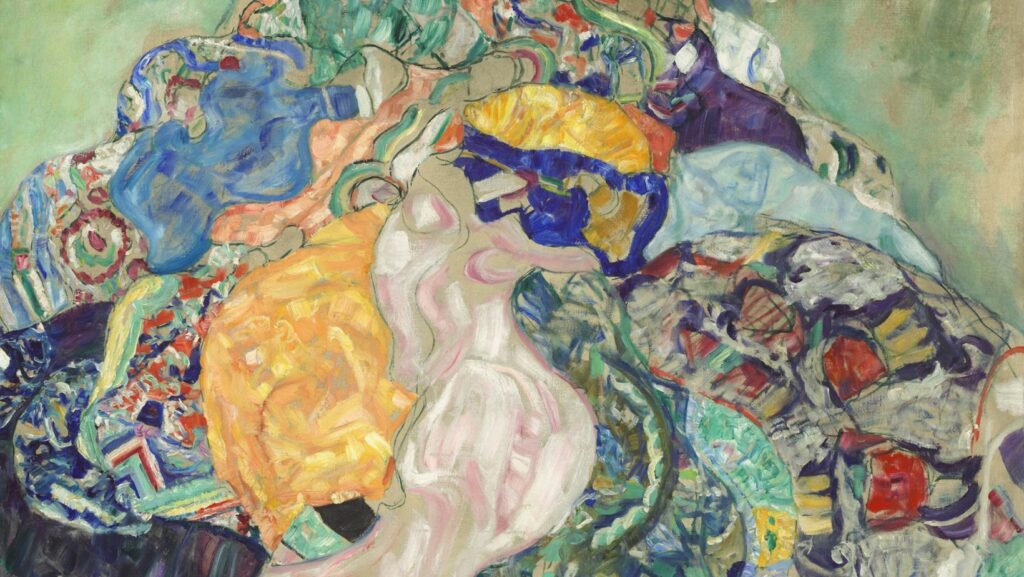
“The Kiss” by Gustav Klimt is a masterpiece that has captivated audiences for over a century, becoming one of the most iconic images of love and intimacy in the world of art. This article delves into the history, symbolism, and enduring legacy of Klimt’s most famous work.
Gustav Klimt, an Austrian Symbolist painter and one of the most prominent members of the Vienna Secession movement, created “The Kiss” between 1907 and 1908. During this period, Klimt was at the height of his “Golden Phase,” characterized by the use of gold leaf in his works. This phase produced some of his most critically acclaimed pieces, with “The Kiss” being the pinnacle of his achievements.
The painting depicts a couple locked in an intimate embrace, surrounded by a field of gold that seems to elevate them from the earthly realm to a spiritual or heavenly dimension. The man is bending over the woman, kissing her on the cheeks, as she, in turn, closes her eyes, lost in the moment. The figures are adorned in elaborately patterned robes that merge almost seamlessly with the golden background, creating a sense of unity and timelessness.
“The Kiss” is often seen as a celebration of love and passion, transcending the physical to touch on the spiritual. The use of gold leaf not only adds a divine quality to the image but also pays homage to the Byzantine mosaics that Klimt admired, bringing a sense of the sacred to the depiction of a secular subject.
The composition of the painting is masterful, with Klimt using geometric shapes and patterns to create a harmonious whole. The figures are enveloped in a cloak of gold, with the man’s robe decorated in rectangular motifs, symbolizing masculinity and strength, while the woman’s dress features circular motifs, signifying femininity and gentleness.
Klimt’s inspiration for “The Kiss” is a subject of much speculation. Some art historians suggest that the painting reflects the artist’s own love affairs and his view of the ideal relationship, where love is both a physical and spiritual union. Others see it as a more general ode to love’s power to transcend the mundane.
The painting was first exhibited in 1908 and immediately garnered widespread acclaim. It was purchased by the Austrian government even before the exhibition closed, a testament to its immediate impact on the art world and the public.

Over the years, “The Kiss” by Gustav Klimt has become not just a symbol of love but also of the Art Nouveau movement, with its emphasis on organic forms, flowing lines, and the integration of decorative elements into art. Klimt’s work stands as a testament to the movement’s ideals, blending beauty, eroticism, and modernity in a way that was revolutionary at the time.
The popularity of “The Kiss” has only grown over the decades, with reproductions adorning countless walls around the globe. It has become a ubiquitous symbol of romantic love, celebrated in Valentine’s Day cards, posters, and even merchandise.
Critics have lauded “The Kiss” for its technical brilliance and emotional depth. The intricate patterns and use of gold leaf are seen as a pinnacle of Klimt’s artistic skills, while the emotional resonance of the painting has made it a favorite subject of study for art historians and psychologists alike.
The legacy of “The Kiss” extends beyond the art world. It has inspired countless artists, writers, and filmmakers, who see in Klimt’s work a universal depiction of love and intimacy. Its influence can be seen in various forms of media, where the themes of love, passion, and transcendence continue to resonate.
Moreover, “The Kiss” has played a significant role in popularizing Klimt’s work, making him one of the most celebrated artists of the 20th century. The painting’s success paved the way for a renewed interest in Klimt’s oeuvre, leading to exhibitions and retrospectives around the world.
The painting also holds a special place in Austria’s cultural heritage, symbolizing the artistic innovation and cultural flourishing of Vienna in the early 20th century. It is a reminder of a time when the city was at the forefront of the modernist movement, challenging traditional norms and embracing new ideas in art, music, and literature.
“The Kiss” by Gustav Klimt is currently housed in the Österreichische Galerie Belvedere in Vienna, where it continues to draw visitors from all over the world. Its allure remains undiminished, a testament to Klimt’s genius and the universal appeal of its subject matter.

In conclusion, Gustav Klimt’s “The Kiss” is more than just a painting; it is a cultural icon that represents the pinnacle of artistic achievement during the Art Nouveau period. Its blend of eroticism, spirituality, and beauty has made it an enduring symbol of love, captivating viewers with its golden glow and intimate embrace. As we reflect on its significance, “The Kiss” reminds us of the power of art to express our deepest emotions and to connect us across time and space.



